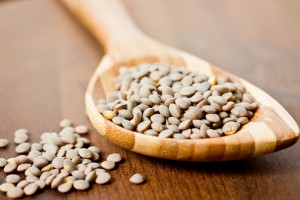 How can such a tiny bean pack such a powerful punch? The health benefits of lentils extend far beyond their high fiber and vegetable protein that benefit digestion, heart health, blood sugar stabilization and weight loss to other areas such as …………
How can such a tiny bean pack such a powerful punch? The health benefits of lentils extend far beyond their high fiber and vegetable protein that benefit digestion, heart health, blood sugar stabilization and weight loss to other areas such as …………
you got it………BONE Health!
Lentils are part of the legume family which also includes beans and peas. Most health experts recommend increasing the consumption of legumes because they provide an array of nutrients and phytochemicals that have beneficial health effects. In fact, eating legumes has been shown to be the most important dietary predictor of longevity!
How do lentils support bone health?
1. Provide a rich source of many essential bone building minerals and vitamins
2. A vegetable protein source that helps to balance pH levels
3. Good source of iron
4. Good source of phytates
You might have thought that iron was solely important for transporting oxygen around the body; an iron deficiency, or anemia, can leaving you feeling weak and tired. However, there is emerging evidence that iron deficient anemia is also a risk factor for osteoporosis. A study out of Taiwan found that osteoporosis occurred more often in patients with iron deficient anemia than those with normal iron levels. This study showed a near two-fold risk for osteoporosis in patients with a history of iron deficient anemia. Though not fully understood, it is believed that anemia not only stimulates the production of new blood cells, but also osteoclasts, cells break down bone.
Adding lentils to your diet is a great way to boost your iron levels naturally. Lentils provide 38% of iron needed daily for woman. However, lentils, as well as all plant foods, are a source of non-heme iron which is not as easily absorbed as the heme iron found in animal proteins. You can increase the absorption of iron from plant foods by combining them with vitamin C rich foods.
What’s a phytate and how can it help to strengthen my bones? Phytate or phytic acid is a naturally occurring compound found in plant foods such as legumes, grains and nuts. For years there has been concern that the consumption of foods containing phytates can negatively effect bone health because phytates can decrease the absorption of key bone building minerals such as iron, calcium, magnesium and zinc. However, a recent study found that women who had the highest levels of phytates had less bone loss and fewer fractures. Therefore, it appears that a phytate-rich diet that includes lentils, beans, nuts and whole grains may actually help protect against osteoporosis. You can also enhance the absorption of minerals from phytates by combining nuts and legumes with garlic and onions. Compounds in garlic and onions have been shown to increase the uptake of minerals such as zinc and iron up to 70%.
Because lentils have so many health benefits and are loaded with valuable bone building nutrients, adding lentils to your diet will not only help build up your bones, but also your body as a whole.
You may think of lentils as a winter food, usually used in warm comforting soups and stews, but check out this wonderful Lentil Summer Salad that makes a cool and refreshing meal or side dish.
Summer Lentil Salad

Ingredients
Dressing:
2 TBSP wihite balsamic Vinegar
2 TBSP Extra Virgin Olive Oil
2 tsp of Dijon Mustard
Pinch of Sea Salt
Salad:
2 cups peeled and cubed cucumber, approximately 1/2 inch cubes
1 cup sliced cherry tomatoes
2 cups cooked lentils (green or red)
1/2-3/4 cup crumbled feta cheese or crumbled goat cheese
4 fresh basil leaves, minced
Preparation
Cook lentils according to package directions until tender, but not mushy, approximately 22 minutes
In a small bowl, whisk together the dressing ingredients and set aside
Combine cucumbers, tomatoes, cheese and fresh basil leaves
When lentils have cooled, add to cucumbers and tomatoes
Add dressing and gently toss
References:
- North Dakota State University. (n.d.). Retrieved June 26, 2017, from https://www.ag.ndsu.edu/food/pulse-crops/research/legumes-are-the-most-important-dietary-predictor-of-longevity
- Pan, M., Chen, L., Tsao, H., & Chen, K. (2017). Iron Deficiency Anemia as a Risk Factor for Osteoporosis in Taiwan: A Nationwide Population-Based Study. Nutrients,9(6), 616. doi:10.3390/nu9060616
- FACLM, M. G. (n.d.). Phytates for the Prevention of Osteoporosis. Retrieved June 26, 2017, from https://nutritionfacts.org/video/phytates-for-the-prevention-of-osteoporosis/
- Higher Bioaccessibility of Iron and Zinc from Food Grains in the Presence of Garlic and Onion. (n.d.). Retrieved June 26, 2017, from http://pubs.acs.org/doi/abs/10.1021/jf100716t






